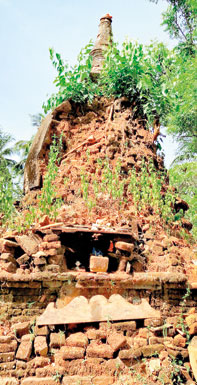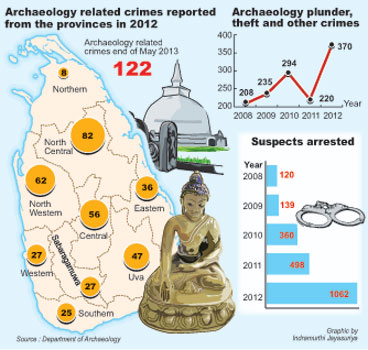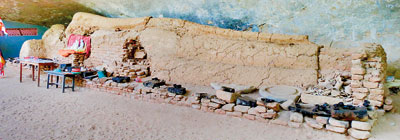News
There’s very little left to plunder
Massive holes in national heritage as unholy, unchecked and unabated desecration of archaeological sites by moneyed ‘investors’ continues with impunity.
Hundreds of archaeological sites, the majority of them Buddhist temple complexes, are plundered every week by organised gangs scouring for ancient treasure.

Ihawa Temple. Pix by Ashan Geeganage
The depredation is so acute that 122 offences were reported to the Archaeological Dept in the first five months of 2013 alone. This amounts to around 25 incidents a month, or six a week. Last year, 370 violations were reported. It was the highest total in five years.
The offences include theft of artefacts, destruction of antiquities and archaeological sites, illegal excavation and other violations of The Antiquities Ordinance.
Police say modern machinery such as backhoes, are widely used for digging. “Very little is done by hand now,” explained Inspector (IP) Rohana Chaminda, Officer-in-Charge (OIC) of the Department’s Antiquities Protection Division in Colombo.
This confirms the presence of moneyed ‘investors’ among the pillagers. The gangs invariably include one or more local inhabitants, but investigations reveal that the main instigators are usually from outside the respective villages. Speaking on condition of anonymity, officials also hinted at the involvement of members of the military and police, as well as Buddhist monks in some of these offences.“It is my belief that at least 75% of sites have already been dug up,” said archaeology enthusiast Dr Niroshan Edirisinghe, based in Polonnaruwa. “I think there are very few places left for anyone to plunder. I have seen how treasure hunters have destroyed sites that the Dept hasn’t officially identified yet.”
“I recently visited a place called Kosgaha Ulpatha in the Polonnaruwa district,” he continued. “There is nothing left of the chaitya. Treasure hunters have dug deep pits. The reclining Buddha statue was also destroyed. You can only see the pieces.”
Dr. Edirisinghe is part of an online community of wildlife, nature and archaeology lovers called Lakdasun. Its members routinely visit places of interest around Sri Lanka, and share their experiences through the website. Their published material include countless photographs of vandalism, including, not just treasure hunting, but graffiti.
With the end of the war, previously unexplored areas in the North and East have become accessible. “I have heard there is heavy activity now in the East, particularly around Toppigala,” one frequent traveller said. (Even the summit of Toppigala, which people can now climb with an army escort, holds the remains of an ancient temple complex). He warned that dozens of unprotected archaeological sites inside restricted areas in Yala were also at risk.

“Nobody goes to check,” he asserted. “So these areas are vulnerable. Sites inside wildlife parks are particularly open to plundering.”
OIC Chaminda said he could not corroborate reports of increased treasure hunting in the East. He pointed out that, within the first five months of 2013, only nine violations were reported from that Province. In contrast, 35 offences were recorded from the North-Central province, and 21 from the North-Western Province.
However, it is possible that, fewer violations are reported from the East because many areas are still not populated; the sites, which are often in the jungle, have not yet been identified and excavated by the Archaeology Dept; monitoring and protection is weak or nonexistent; and there is insufficient awareness among inhabitants of the need to preserve Sri Lanka’s heritage, among other reasons.
Some of this is about to change.
Last week, the Archaeological Dept started a programme in the East, to research and document historical sites throughout that Province. Police and university students are among those enlisted to conduct the six-month initiative.
Dr Ashan Geeganage, another Lakdasun member based in Moneragala, has visited around 150 archaeological sites during the past year. “Treasure hunters won’t leave even a stone column alone,” he said. “They think it is a sign of treasure.”
“Many ‘sandakadapahan’ have been cracked open,” Dr Geeganage recounted. “Pits, sometimes 20 to 30 feet deep, have been dug inside caves where monks used to meditate. Ancient chaityas have gaping holes in the middle, sometimes as deep as irrigation wells. Buddha statues have been taken apart, the stomachs scooped out and their faces destroyed.”

Taru Lengala Hermitage, Hulannuge
At Kinihira Kanda, the head of an ancient Buddha statue was dug out using the ‘trishula’ from the statue of a Hindu deity nearby. “Is there no fear, no reverence?” asked a female traveller from Lakdasun, who witnessed the sight. “It’s mind boggling that anyone would have the courage to do that.”
Commenting on the depth of pits dug at some historic sites, she remarked, “You dare not go near some of the larger holes, because you might just end up in China!” Dr. Geeganage said the Uva Province was neglected by authorities, despite being strewn with thousands of archaeological sites, such as Raja Maha Viharas. “They are scattered all over the place,” he explained, adding that, this made them difficult to protect and easy to desecrate.
Some treasure hunters go to amazing lengths. “I went to Nuwaragala in Maha Oya,” he related. “There is a mountain on top of which is a 55 by 75 feet historical pond. The villagers told me that people had once tried to pump water out of the pond to look for treasure at the bottom. They failed because they couldn’t get all the water out.”Dr. Geeganage has learnt of instances where miscreants, having shaved their heads and dressed up like monks, went into the jungle to ‘meditate’. “There are usually sites nearby, and while ‘meditating’, they started digging on the side,” he said.
“Anywhere there is an archaeological site, people think there is treasure,” he lamented. “It’s such a mania now. And I can’t say this will end. It’s reached such levels, that you need a door-to-door education campaign, similar to our dengue eradication programme.”
Stricter penal deterrent awaits Cabinet approval while fear of the gods remains potent
Concerned heritage lovers believe that one way to stop treasure hunting is to instill the fear of the gods in potential miscreants.
“I think there’s something to be said for this strategy,” said an archaeology enthusiast who did not wish to be named. “There is strong belief among villagers in ‘vas dos’, and that’s why they make offerings to the gods and spirits before digging up a site.”
Other travellers reported how villagers often speak of violent deaths—mostly road accidents—that coincide with episodes of treasure hunting. “Sometimes, we talk to them about how people who desecrated temples have suffered mysterious fates,” this traveller said. “We ask them whether they had heard how, in such and such a place, a whole family died after a temple was broken into.”
“How else can you stem this tide of plunder?” she questioned. “Sri Lanka is just plastered with archaeological sites, the Dept is so understaffed and the scale of the problem so large.” “There are thousands and thousands of sites,” agreed former Director-General of Archaeology, Dr Siran Deraniyagala. “There is no way you can supervise all of them.”
“Money is the main motivation,” he added. “They believe there is treasure, so they keep on destroying monuments. The answer is to educate the public not to destroy national heritage. They will say their stomachs are more important than national heritage. What do you say to that?”
One solution to the treasure hunting would be to augment the punishments meted out. Director-General of Archaeology Dr. Senerath Dissanayake said changes to The Antiquities Ordinance are now with Cabinet for approval. Once passed, the minimum punishment for offences will be Rs 200,000 (up from Rs 50,000) and the maximum Rs 2 million (up from Rs 250,000). The destruction of archaeological sites and artefacts will entail a mandatory prison term.
Another alternative is to conduct a massive education campaign, targeting groups such as school children. The Dept already holds programmes all over the country, and there is increasing awareness at village level of the importance of archaeological sites. Consequently, there is heightened vigilance now.
And, yet, the pillaging continues. Could it be that influential vested interests don’t want it to stop?
Follow @timesonlinelk
comments powered by Disqus

